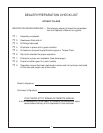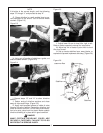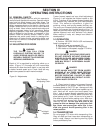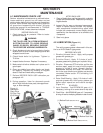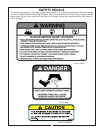
SECTION III
OPERATING INSTRUCTIONS
3-1 GENERAL SAFETY
Only qualified people familiar with this operator’s
manual should operate this machine. Operator should
wear hard hat, safety glasses, and safety shoes. The
operator should read, understand and practice all
safety messages shown on the caution, warning, and
danger decals affixed to the tiller to avoid serious
injury or death. Use a rollover protective structure and
seatbelt equipped tractor for all operations. Before
beginning operation, clear work area of objects that
may be picked up and thrown or wrapped in tiller
blades. Check for ditches, stumps, holes, or other
obstacles that could upset tractor or damage tiller.
Always turn off tractor engine, set parking brake, and
allow rotor to come to a complete stop before dis-
mounting tractor.
3-2 ADJUSTING FOR WORK
Depth of till is regulated by adjusting skids up or
down. (Figure 3-1) Average soil with reasonable
moisture will allow maximum depth in one pass with
a tractor forward speed up to 2 mph. Hard soil may
require two passes to reach maximum depth.
3-3 OPERATION
A. Perform BEFORE EACH USE maintenance
listed in paragraph 4-1.
B. Adjust for work per paragraph 3-2.
C. Start tractor. Raise tiller off the ground.
D. With tractor at idle speed, engage PTO drive.
E. Place tractor in gear and proceed forward.
Increase speed to 3/4 throttle. Lower tiller into soil.
Increase speed to 540 PTO rpm. Average soil with
reasonable moisture will allow travel speeds up to 2
mph. Hard soil will require low travel speed, less
than 1 mph to ensure smooth operation and maxi-
mum possible depth. Shallow weed cultivation will
allow speeds up to 3 mph. At the end of a pass lift
tiller clear of ground before making a turn. After turn-
ing, proceed back across field, slowly lowering the
tiller into the soil. Do not turn with tiller in the
ground as this can damage tiller and tractor link-
age. Never use reverse gear while tiller is low-
ered into ground. Avoid operating tiller in the
raised position.
3-4 TRANSPORTING
Do not engage PTO drive while transporting tiller.
Obey all state and local laws when transporting on
public roads. Always use flashing warning lights
unless prohibited by law.
DANGER
STAY CLEAR OF ROTATING DRIVELINES.
DO NOT OPERATE WITHOUT DRIVELINE
SHIELDS IN PLACE AND IN GOOD CONDI-
TION. FAILURE TO HEED THESE WARN-
INGS MAY RESULT IN PERSONAL INJURY
OR DEATH.
KEEP HANDS AND FEET FROM UNDER
MACHINE AT ALL TIMES. MAKE CERTAIN
EVERYONE IS CLEAR OF MACHINE
BEFORE OPERATING. FAILURE TO HEED
THESE WARNINGS MAY RESULT IN PER-
SONAL INJURY OR DEATH.
9
DANGER
WARNING
THE TILLER CAN FALL FROM
HYDRAULIC SYSTEM FAILURE. TO
AVOID SERIOUS INJURY OR DEATH,
SECURELY SUPPORT TILLER BEFORE
WORKING UNDERNEATH.
Tractor forward speed and rear shield adjustment
(Figure 3-1) will regulate the finished results or tilth
of soil. Traveling at the slowest forward speed with
rear deflector fully lowered will give finest possible
finish. This deflector adjustment is good for
mulching, mixing, and burying weeds, fertilizer, etc.
The more you increase forward speed and deflector
height, the coarser the finished results will be. To
leave the ground surface rough with larger clods and
residue exposed, work with deflector fully raised.
When working in rocky soil, always have shield in
raised position.
Figure 3-1 Adjustments
Rear Deflector
w/Adjusting Chain
Skid
Parking Stand
Height
Adjuster





